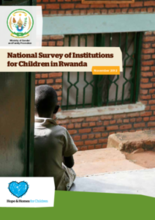In March 2012, the Cabinet of the Republic of Rwanda approved the National Strategy for Child Care Reform. The aim of the strategy is to transform Rwanda’s current childcare and child protection system into a family-based, family-strengthening system whose resources (both human and financial) are primarily targeted at supporting vulnerable families to remain together. The strategy recognises that transformation of institutions (sometimes known as orphanages) is an entry point to building sustainable childcare and child protection systems. The first phase, estimated to take 24 months, therefore specifically aims to ensure the closure of 33 institutions and placement of all 3,323 children and young adults living in them into alternative care.
A vital first step in the process is to obtain an accurate picture of the current institutional system and the children living within it which can be used to inform decision-making regarding the implementation of the reform strategy and provide a baseline against which progress can be measured in the future. For this reason, Hope and Homes for Children, in partnership with the Ministry of Gender and Family Promotion (MIGEPROF), has conducted a national survey of all institutions for children in Rwanda. The survey covered all 33 institutions for children without parental care that are registered with MIGEPROF with the exception of one institution, Mpore PEFA, which was in the process of being closed through a pilot deinstitutionalisation project. The survey was intended to gather comprehensive quantitative data about all children living in institutions in Rwanda, gather qualitative data from a sub-sample of children concerning their personal experience of living in institutions, gather data about the institutions and their staff, and to identify existing interventions in the priority areas of the reform process.
Among its key results, the study found that 37.5% of children were aged 0-3 years at the time when they were placed in the institutions; 29.9% of children currently living in institutions have already spent more than 10 years in the institution; and the most common reasons for children being placed in the institution include death of one or both parents, abandonment, and poverty. Furthermore, the study found that most children are referred to institutions by their parents, relatives, or local authorities and there is generally a lack of data concerning children and young people who have left institutions. The study recommends that all children be moved to family-based care, with the youngest children to be moved out as soon as possible. The study also suggests that family separation prevention services must be supported and developed at the community-level and that children be supported in their transition to independent living after leaving care. The report also includes recommendations for care plans, maintaining family connections for children out of family care, improving or creating data recording and monitoring systems, improving the child protection knowledge and skills of local authorities, conducting future research, and more.
©Ministry of Gender and Family Promotion (MIGEPROF) and the National Commission for Children (NCC)

